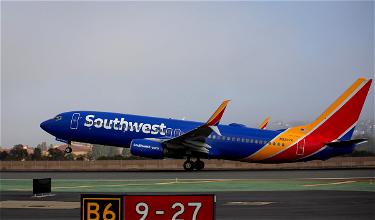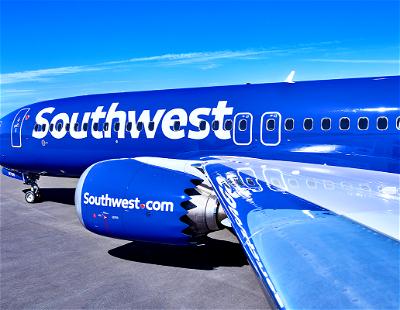A private jet trying to land at San Diego Airport came within 100 feet of the runway where a Southwest Boeing 737 was waiting to take off. What went wrong here?
In this post:
Close call at San Diego Airport due to distracted ATC
This incident happened on Friday, August 11, 2023, at San Diego International Airport (SAN). It involves a Southwest Airlines Boeing 737-700 with the registration code N7734H that was scheduled to fly to San Jose, and a Cessna Citation 560X with the registration code N564HV that was scheduled to arrive in San Diego.
Long story short, the Southwest Boeing 737 was on the runway waiting to take off, while the Cessna Citation had been cleared to land on the same runway. The Cessna Citation was just 100 feet off the ground when a go around was executed, as the Southwest Boeing 737 hadn’t yet been cleared for takeoff.
The best way to understand the incident is to watch the below VASAviation video, which contains both the air traffic control audio, and a recreation of the movement of the aircraft.
To summarize what happened:
- The air traffic controller cleared the Cessna Citation to land on runway 27
- The Southwest Boeing 737 was cleared to line up and wait on runway 27, with a warning that the Cessna Citation was on a five mile final
- The air traffic controller seemingly focused on things that shouldn’t have been top priority, like issuing other aircraft route amendments
- You can hear the pilot of the Cessna Citation on final approach try to verify that they still had landing clearance, but they got cut off by a transmission from the air traffic controller
- Finally as the Cessna Citation was about to touch down, the air traffic controller told them to go around and fly a missed approach
- At this point the Southwest Boeing 737 was also advised to clear the runway, because there was another aircraft on two mile final
The Southwest Boeing 737 departed within 15 minutes, and the Cessna Citation also managed to land again within 15 minutes, after performing a go around.
The NTSB is now investigating this incident:
“NTSB investigating Aug. 11 runway incursion and overflight at San Diego Int’l Airport that occurred when a Cessna 560X was cleared to land on Runway 27 and conflicted with a Southwest Airlines Boeing 737 which was in a line up & wait on Runway 27. No injuries or damage reported.”
My take on this San Diego Airport incident
Air traffic controllers have really stressful jobs, and they have a lot of things they have to manage at once. A mistake from an air traffic controller could have catastrophic implications.
With that in mind, this air traffic controller obviously screwed up. She cleared an aircraft to land, and cleared an aircraft to taxi into position and hold on the same runway, and then seemingly got distracted by other aircraft with less critical needs.
You can even hear the Cessna Citation pilot trying to confirm that they still have clearance to land, but that transmission is mostly blocked by the air traffic controller giving another pilot instructions.
Fortunately I think this situation was a little further away from being a catastrophe than some other incidents we’ve seen recently:
- This was during the daytime, and visibility was good, so the Cessna Citation pilots presumably saw the Southwest Boeing 737 on the runway
- The one thing I’m confused about is why the Cessna Citation pilots continued their approach until seconds before they were supposed to land, when they could presumably see the plane on the runway; it seems like waiting until you’re within 100 feet of the runway to execute a go around when a plane is on the runway and hasn’t been cleared for takeoff is a bit late
I think it’s also worth mentioning that in many other parts of the world, air traffic controllers only clear planes to land once the runway is free, rather than the conditional clearance we see in the United States. I’ve always thought the former system makes more sense. If you ask me, pilots should be cleared to land when… they’re actually cleared to land.
Bottom line
A departing Southwest Boeing 737 and arriving Cessna Citation were uncomfortably close on runway 27 at San Diego Airport. The air traffic controller had cleared the Cessna Citation to land and had also cleared the Southwest 737 to taxi onto the runway, without permission to take off.
Fortunately this situation had an okay ending, but this has to be one of the bigger mistakes we’ve seen from an air traffic controller, as she seemingly lost focus.
What do you make of this San Diego Airport ATC incident?





She needs to fired to set an example to others who become incompetent at their job.
You've earned the giant eye-roll award, Tom!
Nobody here has enough information about the situation to decipher whether the controller was "incompetent." The things I've heard within the industry suggest the opposite.
Also, the consequences of firing anyone in an already dangerously understaffed field... that may end up getting people killed more quickly than if we just let less-than-perfect people keep working. So there's that.
While conditional clearances (if that’s what is actually called) are rare in the rest of the world, I assume if executed effectively, does increase efficiency with more aircraft landing and departing from the runway without needing additional runways. However, they clearly haven’t executed it effectively, hence no one else but the U.S. regularly relies on it.
It's not actually called a conditional clearance.
Ironically, in many other places around the world, they have actual "conditional" clearances, while the U.S does not. For instance, some places can instruct a plane to line up and wait behind landing traffic. In the U.S, that's not allowed. Presumable we restrict this because of the potential disaster if the pilot misses the conditional portion of the clearance.
Pilots who see an aircraft on the runway when on very short final should recognize the situation and execute a missed approach without being told by the controller. We all have to work together to ensure safety and prevent close calls that get media attention. The controller still will get dinged by their lapse of situational awareness however there was no good rational by the pilot to continue the approach when it was obviously not...
Pilots who see an aircraft on the runway when on very short final should recognize the situation and execute a missed approach without being told by the controller. We all have to work together to ensure safety and prevent close calls that get media attention. The controller still will get dinged by their lapse of situational awareness however there was no good rational by the pilot to continue the approach when it was obviously not going to work. I've saved the butts of many pilots catching errors and pilots should do the same. It's a team effort.
Part of the blame goes on the residents of San Diego.
Could've had a two runway airport with the Miramar swap.
I grew up and went to college in SAN, moving the airport has been a topic of controversy for decades. Truly a missed opportunity. and SAN is just about out of space to grow on Harbor Drive. Sad, the area deserves a much nicer airport.
The military did not want to give up Miramar. The residents around Miramar did not want a commercial airport there.
Silly that Cessnas are landing there, use Brown field or any of the 3 less busy airports. Make the landing fee at Limbergh so restrictive that only major airlines can afford it. I remember watching from the windsock restaurant, above Jim's air, military jets using the only runway to make an emergency landing, causing an evergreen plane taxing on the only runway to go shooting across the infield and almost into the terminal, TRACON screwed up that one.
SAN has a displaced runway threshold of 1,800 feet, meaning arriving aircraft aim to touch down quite a bit further down the runway than where departing aircraft line up and wait. So at least there’s a bit of a safety margin built in for this kind of situation, not that it’s at all acceptable.
Guess I'm not following all the comments about conditional clearances. What I read is 4HV is cleared to land. Then 34H is cleared to LUAW. Where's the conditional instruction?
They're referring to how landing clearances are often delivered in the US. In the rest of the world, you will likely get your landing clearance on short final, when the runway is actually yours. In the US, they will issue your clearance early, and then continue using the runway until you're actually landing.
There's nothing communicated about a "conditional" clearance, but that's how it works out. ICAO clearance: the runway is yours, you may land....
They're referring to how landing clearances are often delivered in the US. In the rest of the world, you will likely get your landing clearance on short final, when the runway is actually yours. In the US, they will issue your clearance early, and then continue using the runway until you're actually landing.
There's nothing communicated about a "conditional" clearance, but that's how it works out. ICAO clearance: the runway is yours, you may land. FAA clearance: I think the runway will be clear, and you may land unless I tell you otherwise.
For clarification, LUAW and concurrent landing clearances can only be issued at airports with ground radar, which alarms in the tower at a certain point. Not really sure the semantics/timing, but it's likely that the alarm is what eventually alerted the controller to send the jet around.
Also concur that it's strange the pilot was still preparing to land. Typically, I'd say any public concerns about ATC ability should be quelled by the Swiss Cheese...
For clarification, LUAW and concurrent landing clearances can only be issued at airports with ground radar, which alarms in the tower at a certain point. Not really sure the semantics/timing, but it's likely that the alarm is what eventually alerted the controller to send the jet around.
Also concur that it's strange the pilot was still preparing to land. Typically, I'd say any public concerns about ATC ability should be quelled by the Swiss Cheese model. Seems like this one had one more hole than usual.
Yes at SAN Twr they are prone to give conditional landing clearences to a lot of aircraft at the same time, up to 5-6 aircraft are cleared to land nr x after xx
This is a bad practise and this incident is a prime example of why we dont dont do this in EASA land (EU)
Conditional clearances are dangerous. This just proves it. But good luck trying to get the FAA to admit their practices do not meet international safety standards. Nope, the rest of the world must be wrong.
When factoring the complexity and saturation of U.S airspace, we continue to be the safest country in the world.
Nine of the 10 busiest airports (by aircraft movement) are in the U.S. Some of our policy reflects this, as we may need to do things differently than the rest of the world in order to accomodate the higher demands of air traffic here.
Not to deny the added risk, just to say that the risk/reward ratio is likely adequate.